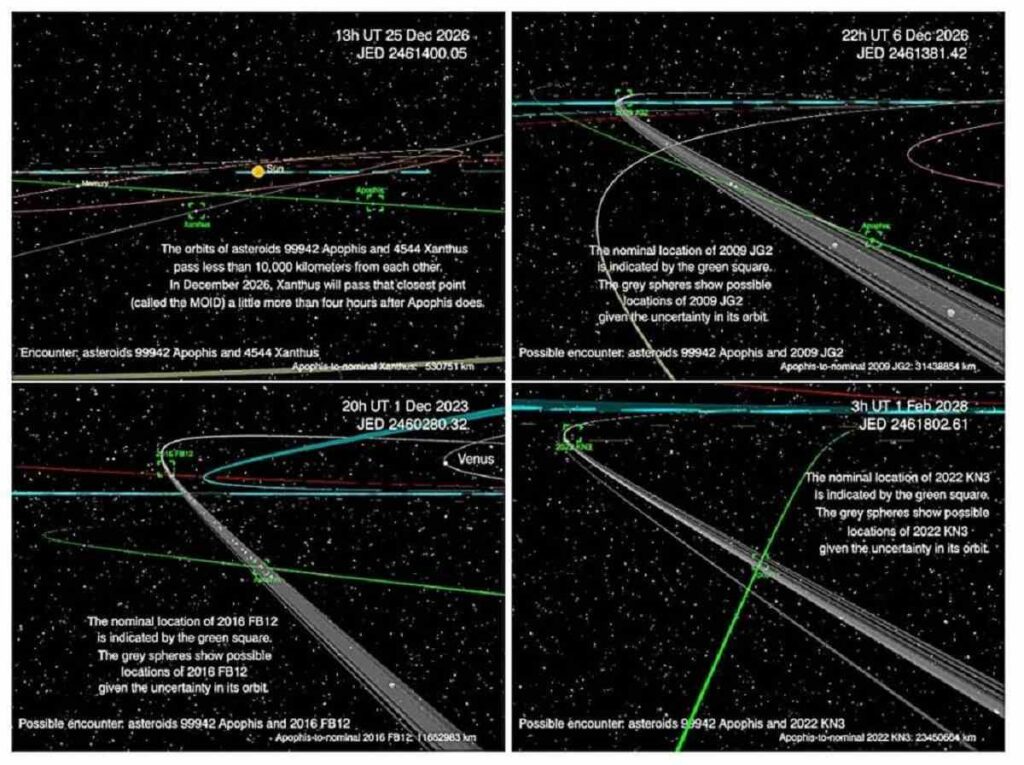Since its discovery in 2004, the asteroid Apophis—often called the “God of Chaos”—has captured the attention of astronomers and space enthusiasts alike. With its massive size and close approach to Earth in 2029, it’s been the subject of much speculation and concern. But before you start worrying about a doomsday scenario, here’s the good news: we’re in the clear, at least for now.
Tracking Apophis: What We Know About Its Path
Apophis, a Near-Earth Object (NEO) measuring about 335 meters in diameter, is expected to pass by Earth at a distance of only 37,399 kilometers on April 13, 2029 (yes, a Friday the 13th!). While that may sound alarmingly close in cosmic terms, scientists have been closely monitoring its trajectory for years, and so far, there’s no reason to panic. Based on the most accurate data we have, Apophis poses no threat of colliding with Earth during this flyby.
What’s exciting for researchers is that this near miss offers a rare opportunity to observe a large asteroid up close without launching a space mission. By studying Apophis’s movement, structure, and composition, scientists can gain valuable insights into how these massive objects behave. This kind of observation could help improve our understanding of asteroid dynamics and even inform future planetary defense strategies.
As Paul Wiegert, an astronomer involved in the research, put it, “Apophis has fascinated us ever since its discovery, especially because it posed one of the first credible threats of an asteroid impact on Earth. Even though we’re now confident that it won’t hit us, it’s an object we can’t stop watching.”
What About the Risk of an Indirect Collision?

One question that often comes up is whether Apophis could be knocked off course by another asteroid. After all, space is full of unpredictable elements, and a collision with another object could potentially shift its trajectory. While the scenario is highly unlikely, it’s not entirely out of the question, which is why astronomers decided to dig deeper into the possibility.
A detailed analysis of over 1.3 million known asteroids was conducted to see if any of them might collide with Apophis before its 2029 approach. The findings were reassuring: none of the objects cataloged in our solar system are on a collision course with Apophis in the near future. This exhaustive study gives scientists even more confidence that the asteroid will safely pass by Earth as expected.
Hyatt, a researcher contributing to the study, explains, “While the risk of Apophis colliding with another asteroid and being diverted toward Earth is extremely low, it’s something we wanted to investigate thoroughly. Thankfully, our data shows that there’s no immediate danger of such a scenario.”
Preparing for Apophis’s 2029 Flyby
The 2029 flyby will be a major event for astronomers, providing an unparalleled opportunity to observe Apophis without the need for an expensive space mission. Ground-based telescopes will be able to track the asteroid closely, gathering data on its size, shape, and surface features. This detailed observation will help scientists understand more about the composition and behavior of asteroids that orbit near Earth.
There’s even potential for space probes or satellites to be sent to get a closer look at Apophis, which could give us even more precise data about its chemical and physical properties. Such a mission would allow us to deepen our understanding of asteroids and their potential risks, particularly those classified as Potentially Hazardous Objects (PHOs).
This kind of research isn’t just about satisfying scientific curiosity. Understanding how these space rocks move and interact with other celestial bodies is key to developing better planetary defense systems. In the event that we do face a serious threat from an asteroid in the future, the knowledge gained from studying Apophis could help us figure out the best way to deflect or mitigate that danger.
The Future of Asteroid Studies
While Apophis isn’t going to crash into Earth anytime soon, its approach offers a chance for scientists to refine their techniques for monitoring and analyzing asteroids. This encounter will provide valuable data that could help us prepare for future asteroid threats. The more we learn about the orbits and characteristics of these objects, the better equipped we’ll be to protect our planet from any potential impacts.
In 2029, when Apophis passes by, it will mark an important milestone in asteroid studies. Not only will it be a fascinating event for space enthusiasts, but it will also contribute to our long-term understanding of how to monitor and respond to the risks posed by Near-Earth Objects.
In summary, while the “God of Chaos” may sound intimidating, we’ve got plenty of reasons to be optimistic about Apophis’s flyby. It’s not just a close encounter—it’s an invaluable scientific opportunity that could help safeguard Earth from future celestial threats.






